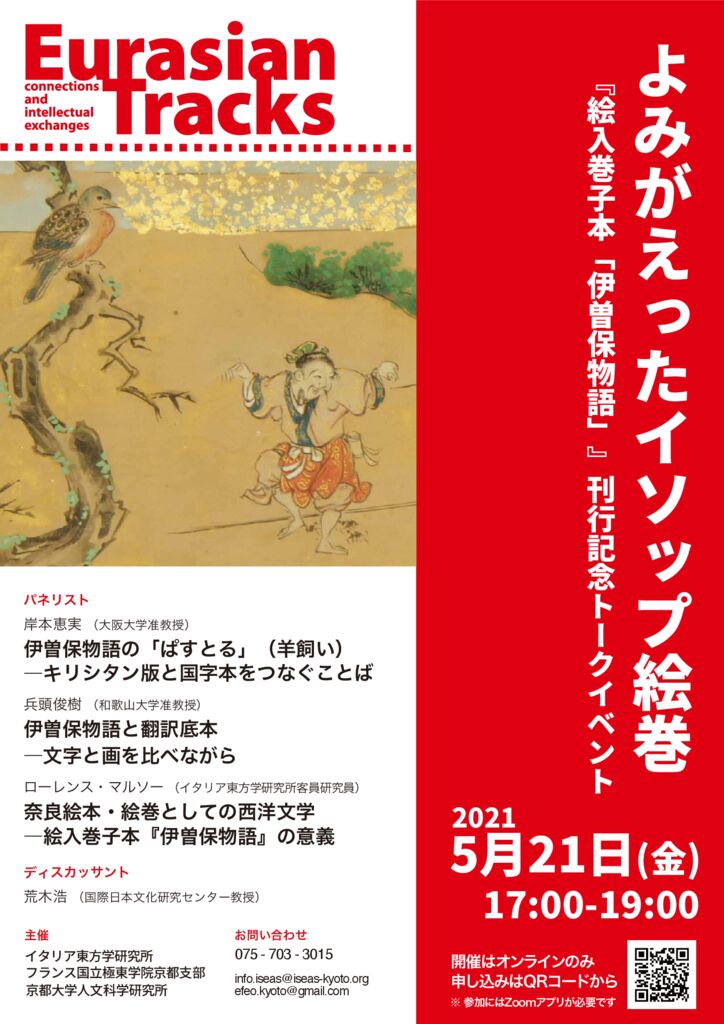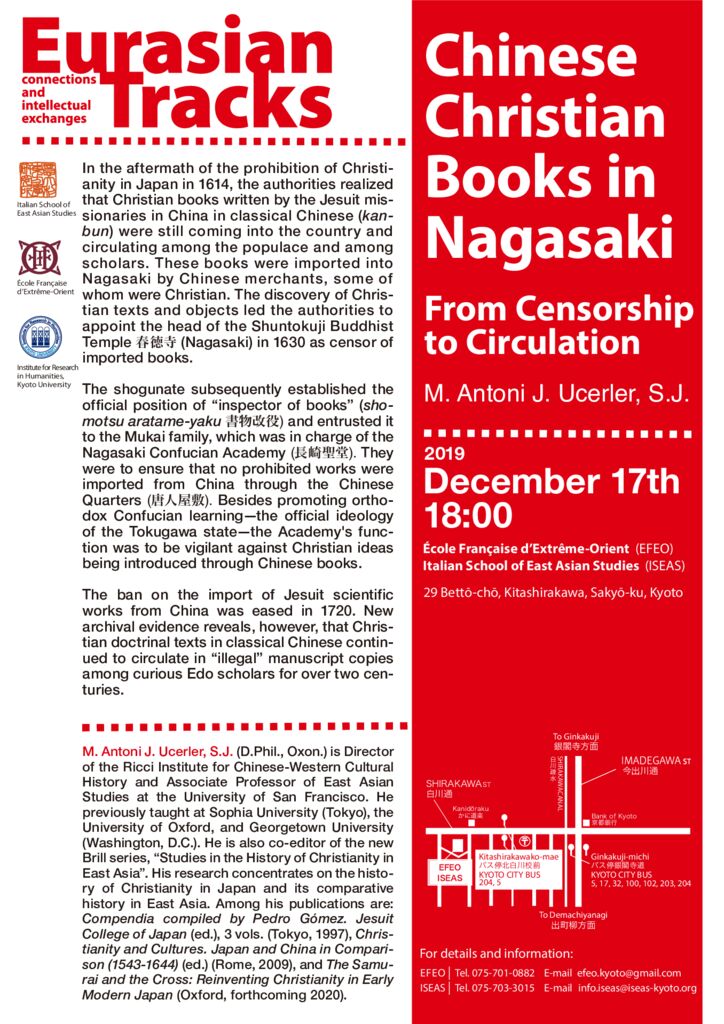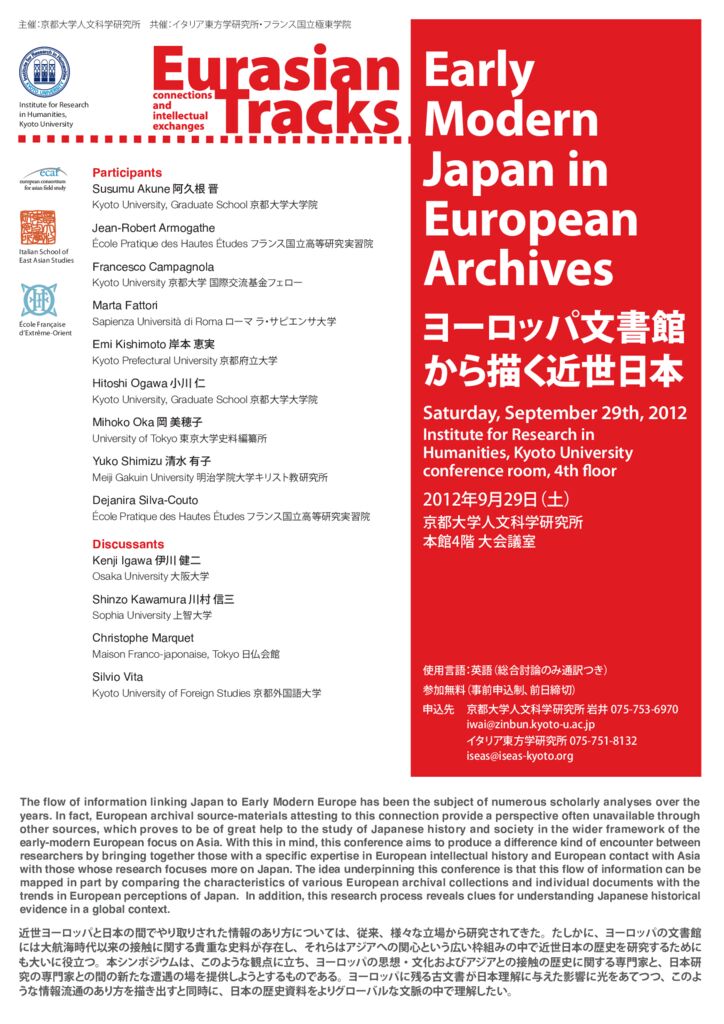Eurasian Tracks
よみがえったイソップ絵巻
『絵入り巻子本「伊曽保物語」』刊行記念トークイベント
21 maggio 2021 17:00 - 19:00
開催はオンラインのみ(Zoomアプリが必要です)
『絵入巻子本「伊曽保物語」―翻刻・解題・図版解説』(臨川書店、二〇二一年刊)の出版を記念して、編者を含む四人の研究者が、中世ヨーロッパ文学、中・近世日本文学、日本語学、美術史など様々な立場から、日本版『イソップ寓話集』の絵巻に切り込む。この絵入り巻子本六巻は十七世紀後半に制作され、奈良絵本・絵巻というジャンルの優れた例である。しかし、『伊曽保物語』の絵巻様式として現在知られる唯一のものであるにもかかわらず、学術的には一九三〇年に一度紹介されたのみであった。刊行をきっかけに、作品の存在を再確認すると同時に、発表者だけでなく、参加者も交えながら、その特徴や背景について語り合う。
パネリスト
■岸本恵実 (大阪大学准教授)
伊曽保物語の「ぱすとる」(羊飼い)―キリシタン版と国字本をつなぐことば
■兵頭俊樹 (和歌山大学准教授)
伊曽保物語と翻訳底本―文字と画を比べながら
■ローレンス・マルソー (イタリア東方学研究所客員研究員)
奈良絵本・絵巻としての西洋文学―絵入巻子本『伊曽保物語』の意義
ディスカッサント
■荒木浩 (国際日本文化研究センター教授)
※使用言語:日本語
■■お申込みはQRコード、またはこちらから
お申込み完了画面で11桁のミーティングIDが発行されますので、メモまたはスクリーンショットにて保存をお願いします。(自動メールは届きません)
後ほど当館から受付確認メールを送信しますが、もし3日以内に届かない場合は再度お申し込みいただくか、メールにてお問い合わせください。
Eurasian Tracks
Chinese Christian Books in Nagasaki
From Censorship to Circulation
M. Antoni J. Ucerler, S.J.
December 17th, 2019 18:00
Italian School of East Asian Studies
In the aftermath of the prohibition of Christianity in Japan in 1614, the authorities realized that Christian books written by the Jesuit missionaries in China in classical Chinese (kanbun) were still coming into the country and circulating among the populace and among scholars. These books were imported into Nagasaki by Chinese merchants, some of whom were Christian. The discovery of Christian texts and objects led the authorities to appoint the head of the Shuntokuji Buddhist Temple 春徳寺 (Nagasaki) in 1630 as censor of imported books.
The shogunate subsequently established the official position of “inspector of books” (shomotsu aratame-yaku 書物改役) and entrusted it to the Mukai family, which was in charge of the Nagasaki Confucian Academy (長崎聖堂). They were to ensure that no prohibited works were imported from China through the Chinese Quarters (唐人屋敷). Besides promoting orthodox Confucian learning—the official ideology of the Tokugawa state—the Academy’s function was to be vigilant against Christian ideas being introduced through Chinese books.
The ban on the import of Jesuit scientific works from China was eased in 1720. New archival evidence reveals, however, that Christian doctrinal texts in classical Chinese continued to circulate in “illegal” manuscript copies among curious Edo scholars for over two centuries.
M. Antoni J. Ucerler, S.J. (D.Phil., Oxon.) is Director of the Ricci Institute for Chinese-Western Cultural History and Associate Professor of East Asian Studies at the University of San Francisco. He previously taught at Sophia University (Tokyo), the University of Oxford, and Georgetown University (Washington, D.C.) He is also co-editor of the new Brill series, Studies in the History of Christianity in East Asia. His research concentrates on the history of Christianity in Japan and its comparative history in East Asia. Among his publications are: Compendia compiled by Pedro Gómez. Jesuit College of Japan, (ed.), 3 vols. (Tokyo, 1997), Christianity and Cultures. Japan and China in Comparison (1543-1644) (ed.) (Rome, 2009), and The Samurai and the Cross: Reinventing Christianity in Early Modern Japan (Oxford, forthcoming 2020).
Eurasian Tracks
Early Modern Japan in European Archives
ヨーロッパ文書館から描く近世日本
2012年9月29日
京都大学 人文科学研究所


